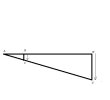[quote author=Casper]
If a nearby lamp highlight finger and projects a picture of him on a nearby wall and wave your finger will notice and that the hay move faster than your finger. If you move your finger parallel to the wall velocity is multiplied by the factor D / d where D is the distance from the lamp to the finger Inc. distance from fingertip to the wall. In fact it can be much faster, if the wall is tapered at an angle. What is a distant wall movement shadows will be slower time needed light to reach the wall, but the speed of shadows is still enhanced by a factor of D / d. Speed shadows is therefore not limited to a speed less than the speed of light.
[/quote]
Yes, this is true. Shadows have no mass. So it does not violate the special theory of relativity as far as I know.
[quote author=casper]
My question would be, given the shadow on this has gravity, given the shadow can be seen as gravitational wave?
[/quote]
I do not know if the shadow is like a gravity wave or not. However, let me share an idea I recently came across from author Sam Avery who wrote a book called "The Dimensional Structure of Consciousness". His idea is consciousness transcends space-time-mass, which is not a new idea but IMO he expresses it well.
Avery considers "dimensions" as contexts of perceptual experience. He uses 4 dimensions of space-time and treats mass as the 5th dimension. Mass is treated as a dimension since mass can be measured or felt through acceleration or deceleration - or through action of forces. The tactile perception senses mass - it can be said that mass arises out of tactile consciousness in this paradigm. Chemo-tactile consciousness is what each living cell has - in that sense it is quite fundamental. Similarly, the 4-D space time arises out of using visual, auditory and olfactory consciousness. Space-time-mass as we experience them can be treated as contexts to organize the perceptual information we obtain through our senses in a meaningful way. However, this is not the only way to organize information.
Light can be treated as visual consciousness which coordinates the perceptions from all other senses providing a whole "picture" of reality that is far greater than the individual experiences of cells of various types and numbers. Visual consciousness per my understanding is not restricted to the physical use of the eyes. Consider as an example the perceptual information coming from sophisticated instruments as an extension of the normal range of human perceptions in this context.
Why "choose" visual consciousness or light rather than auditory consciousness or sound or the other forms of perception? It could be because of the capacity to organize experience is the highest for light. The world would be different if we oriented primarily by sound (like bats) or smell, but doing so by light possibly provides more information.
In this paradigm, light (as visual consciousness) is not "in" space-time-mass reality. Rather, space-time-mass reality that we experience is "in" light. If this is true, then the absolute limit of the speed of light that we measure is a measure of the limits of our perceptual consciousness. As we approach conditions of the speed of light, the fabric of our space-time-mass box gets distorted and we are left with anomalous phenomena in the material world - be it in the relativistic or quantum realms.
Let me indulge in a little more speculation here. The math of special relativity yields imaginary numbers if speed of any mass exceeds that of light. We cannot measure "imaginary" stuff objectively - we need to somehow generate real numbers (through mathematical operations on complex numbers which constitute of both real and imaginary numbers) for them to be measured. Talking metaphorically, thoughts are "imaginary" and we cannot measure speed of thoughts. However, with thoughts we can reach the far reaches of the earth and even the universe without restrictions imposed by the so-called finite speed of light.
If I recall correctly thoughts are said to produce gravity in one session and light is said to be the utilization of gravity. In the dimensional structure of consciousness model, just as light as visual consciousness organizes perceptual experience, thoughts/images as observational consciousness organizes not only actual perceptual experience but also potential experience - that which is not but could be. Expressed differently, paraphrasing Avery, an image in space-time is a perception, an image in time but not space is a thought. An image neither in space or time is perhaps what Jung called an archetype.




 Also just reiterating a lot of what was already said in lay mans terms.
Also just reiterating a lot of what was already said in lay mans terms.